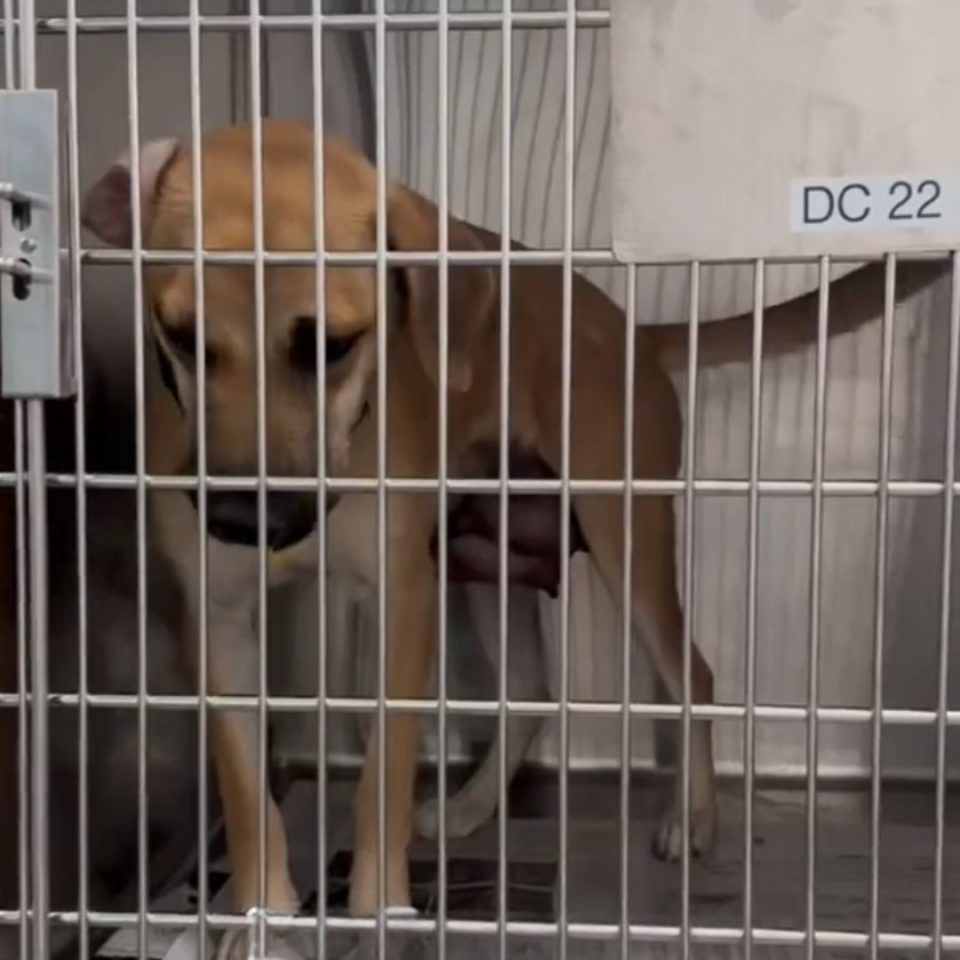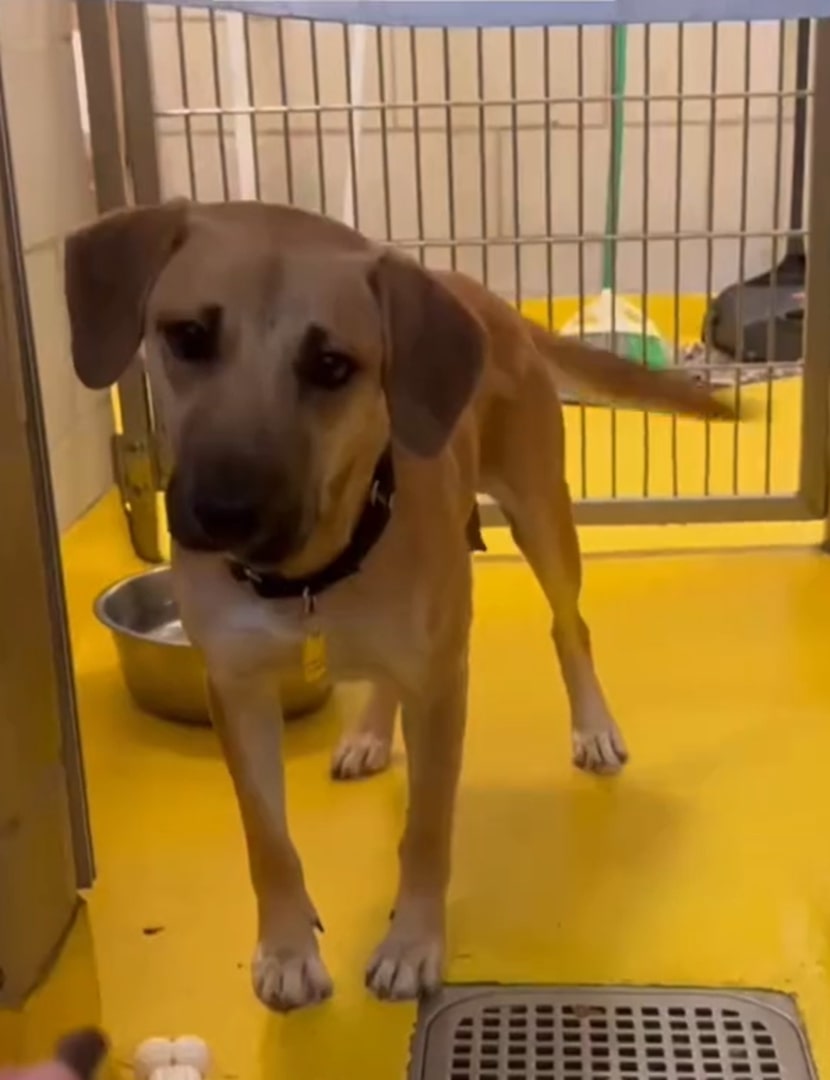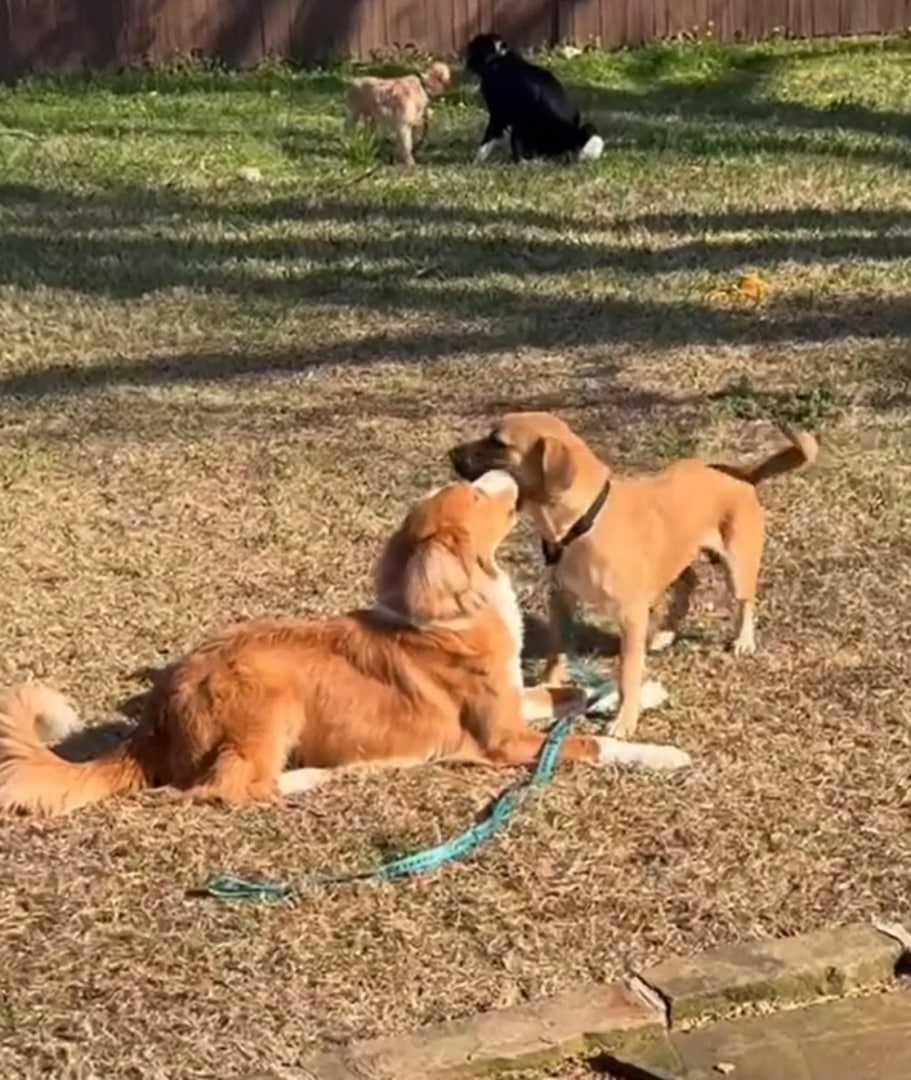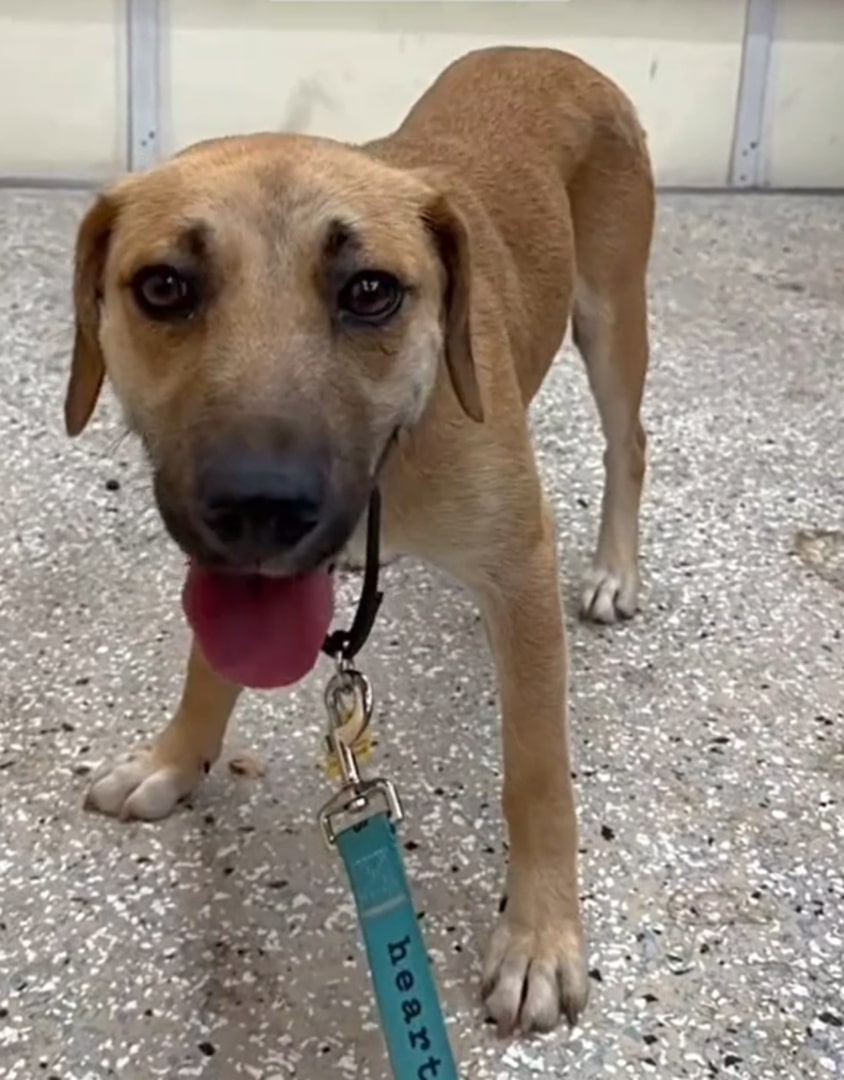Parting ways with the ones you love, even on a short-term basis, is always a heartbreak. Now, imagine being forced to say one last goodbye – forever!
That’s what life has been for Margarita, a sweet shelter dog who was forced to watch every one of her babies go away.
Once she realized that she was all alone and left behind, mom Rita became extremely depressed… until, one day, she completely shut down from the world, uncertain of the future coming her way.
No Momma Dog Should Ever Know This Pain

Then, a miracle happened!
The good people of Heart & Bones Rescue, based in Texas and New York City, dedicated to saving helpless canines from overcrowded shelters, learned Margarita’s story and spared no time to help!

“While we typically rescue families who are at risk in shelter environments, we’ve also got a soft spot for the mamas like Margarita who’s puppies find home while they get overlooked,” HBR wrote on Instagram.
The team was heartbroken by Rita’s story, which eventually resulted in the sweetest, most noble plan ever!
And, within only days, her life completely changed!
Rita On The Way To A New Start

To everyone’s surprise, she completely transformed and became a brand-new dog.
Soon enough, Rita became the sweetest, most loving girl in her new foster home. She adapted to other doggo siblings amazingly, and they loved her, too! She now spends countless hours playing and doing zoomies in the yard, and she just can’t take the smile off her face.

Rita has her very own cuddling rituals, too! Whenever she feels like cuddling with her fosters, she gives them the sweetest, most gentle boop with her nose.
“She arrived in NYC this past weekend and is thriving. She’s a shy but friendly, loving girl who enjoys making new furriends! She may take some time to warm up to you, but once she does, it’s nothing but endless love, cuddles and gentle boops,” the rescue wrote.
There’s still one wish left for this momma, and it’s a biggie!
When the time is right, Rita hopes to find a suitable home and a hooman to love and accompany forever! With the right person on her side, she’s going to be a wonderful companion and a great furriend.
Good luck, Margarita! Hope to see you in a loving home soon!
Ever wondered about the silent threat that lurks in the shadows for our furry companions? Dogs, our loyal friends, can sometimes face a danger that’s invisible yet deadly. Understanding how dogs contract rabies is crucial for every pet owner. It’s a topic that’s often overlooked but holds immense importance in keeping our four-legged pals safe and healthy.
In the hustle and bustle of daily life, we may not always pause to consider the potential risks our dogs face. However, knowing the ins and outs of how dogs can get rabies is a fundamental aspect of responsible pet ownership. So, let’s take a closer look at this vital issue to ensure that you’re well-informed and equipped to protect your beloved canine companion.
Understanding Rabies in Dogs
Rabies is a serious viral disease that affects the nervous system of animals. It’s usually transmitted through the bite of an infected animal. In dogs, rabies can be a life-threatening condition that poses a risk to both pets and humans. Here are some essential points to help you understand rabies in dogs:
1. Transmission:
Rabies in dogs is commonly spread through the saliva of infected animals, usually through bites. It can also be transmitted if the infected saliva comes into contact with mucous membranes or an open wound. Understanding how the disease spreads is crucial in preventing it.
2. Symptoms:
Identifying the symptoms of rabies in dogs early is vital for timely intervention. Common signs include aggression, excessive drooling, paralysis, and behavioral changes. If you notice any unusual behavior in your dog, it’s essential to seek veterinary care promptly.
3. Diagnosis:
Diagnosing rabies in dogs involves observing clinical signs, performing laboratory tests, and checking the animal’s vaccination history. A veterinarian will assess the symptoms and history to make an accurate diagnosis.
4. Treatment:
Unfortunately, there is no cure for rabies once clinical signs appear. The disease is fatal in almost all cases. However, prevention is key. Vaccinating your dog against rabies is the best way to protect them and prevent the spread of the virus.
5. Prevention:
Vaccination is the most effective means of preventing rabies in dogs. In addition to keeping your dog’s vaccinations up to date, it’s essential to avoid contact with wild animals and unknown pets. Responsible pet ownership plays a crucial role in preventing the spread of rabies.
Understanding the basics of rabies in dogs is essential for ensuring the well-being of your furry friend and your family. Stay informed, watch for any unusual symptoms, and prioritize regular vaccinations to keep your dog safe from this deadly disease.
Routes of Rabies Transmission in Dogs
When it comes to rabies, there are primary paths through which dogs can contract this dangerous viral disease. Understanding how these routes work is crucial for safeguarding your furry companion and yourself from the risks associated with rabies.
1. Bite Wounds:
Rabies is commonly spread through the saliva of infected animals, particularly through bite wounds. If your dog is bitten by another animal carrying the rabies virus, there’s a high risk of transmission. It’s essential to seek immediate veterinary care if your dog gets bitten.
2. Scratches:
Although less common than bites, rabies transmission can also occur through scratches from infected animals. Even seemingly minor injuries like scratches can potentially expose your dog to the rabies virus, underscoring the importance of prompt medical attention.
3. Mucous Membranes:
Another route of transmission is through contact with the mucous membranes of your dog. If infected saliva comes into contact with your dog’s eyes, nose, or mouth, the rabies virus can enter their system, leading to infection.
4. Inhalation:
While rare, rabies transmission can also occur through the inhalation of aerosolized rabies virus. This typically happens in situations where infected animals generate droplets containing the virus, which are then inhaled by other animals.
5. Transplacental Transmission:
In rare cases, rabies can be transmitted from a mother dog to her puppies before birth through the placenta. This form of transmission highlights the importance of ensuring that breeding dogs are vaccinated against rabies.
Understanding these routes of rabies transmission in dogs is essential for taking proactive measures to protect your beloved pet. By staying informed and following proper vaccination protocols, you can help prevent the spread of this deadly disease and keep your canine companion safe and healthy.
Symptoms of Rabies in Dogs
When it comes to rabies, knowing the symptoms in dogs is crucial for timely action. Here’s what to watch out for:
- Behavioral Changes: Keep an eye on any unexplained alterations in your dog’s behavior. This could include increased aggression, restlessness, or sudden shyness.
- Excessive Drooling: If you notice your dog drooling more than usual and it’s not related to any known cause, it could be a sign of rabies.
- Difficulty Swallowing: Rabies can affect a dog’s ability to swallow, leading to difficulty in eating or drinking.
- Muscle Weakness: Watch for any signs of weakness or paralysis in your dog, especially in the hind legs.
- Pica: Dogs with rabies may develop pica, a condition where they eat non-food items like rocks or dirt.
- Seizures: Seizures are a serious symptom of rabies in dogs and require immediate veterinary attention.
- Sensitivity to Light and Sound: Rabies can cause dogs to become overly sensitive to light and sound, leading to unusual reactions to stimuli.
- Fever: Keep an eye on your dog’s body temperature. A persistent fever may indicate rabies infection.
If you notice any of these symptoms in your furry friend, don’t wait. Contact your vet immediately for guidance on next steps. Remember, early detection and intervention are key in combating rabies in dogs.
Diagnosis and Testing for Rabies in Dogs
When it comes to diagnosing rabies in dogs, it’s crucial for veterinary professionals to conduct specific tests to confirm the disease. Here’s how the diagnosis and testing process typically work:
1. Clinical Evaluation:
During the initial assessment, your vet will examine your dog for typical rabies symptoms such as behavioral changes, excessive drooling, and muscle weakness. This evaluation helps in indicating a potential rabies infection.
2. History Assessment:
Your vet will inquire about your dog’s vaccination history and potential exposure to rabies. This information aids in determining the risk of infection and the urgency of testing.
3. Laboratory Tests:
To confirm rabies, your vet may conduct a series of tests, including the direct fluorescent antibody test (dFAT) on brain tissue and polymerase chain reaction (PCR) testing. These tests help identify the rabies virus in the dog’s body.
4. Post-Mortem Testing:
Unfortunately, rabies diagnosis often occurs post-mortem. If a dog suspected of having rabies passes away, the brain tissue is examined carefully for the presence of the virus.
Prompt diagnosis and testing are critical in managing rabies in dogs. If you suspect your dog may have been exposed to rabies or is displaying symptoms, don’t hesitate to seek immediate veterinary care for proper evaluation and treatment. Remember, early detection is key to effectively combating rabies and ensuring your dog’s well-being.
Preventing Rabies in Dogs
When it comes to preventing rabies in dogs, there are key steps you can take as a responsible pet owner to keep your furry friend safe and healthy. Here are essential measures to help you protect your dog from this deadly virus:
Vaccinate Your Dog
The most effective way to prevent rabies in dogs is by ensuring they are up to date on their vaccinations. Regular rabies vaccinations are crucial in safeguarding your dog against the virus.
Avoid Contact with Wildlife
Limiting your dog’s exposure to wildlife reduces the risk of contracting rabies. Keep an eye on your dog when outdoors to prevent interactions with potentially infected animals.
Secure Your Property
To prevent encounters with stray animals or wildlife, secure your property with fences or enclosures. This helps create a safe environment for your dog.
Supervise Outdoor Activities
When outside, supervise your dog to prevent them from roaming freely and potentially encountering rabid animals. Stay vigilant during walks or playtime in areas where wildlife may be present.
Seek Veterinary Care Promptly
If you suspect your dog has been exposed to rabies or is showing symptoms, seek immediate veterinary care. Early intervention is crucial in managing the disease effectively.
By following these preventive measures, you can significantly reduce the risk of rabies in your beloved canine companion. Remember, proactive prevention is key to keeping your dog healthy and happy.
Conclusion
So, now you know how dogs can get rabies and why it’s crucial to take preventive measures. Remember, keeping your furry friend safe and healthy is in your hands. By staying informed, getting your dog vaccinated, and being proactive, you can help protect them from this serious virus. Whether it’s limiting contact with wildlife or seeking veterinary care when needed, your actions play a significant role in keeping your dog rabies-free. Stay vigilant, be a responsible pet owner, and prioritize your dog’s well-being. With the right knowledge and actions, you can ensure that your canine companion leads a happy and healthy life, free from the threat of rabies.
Frequently Asked Questions
What is rabies in dogs?
Rabies in dogs is a severe viral disease that affects the central nervous system, usually transmitted through the bite of an infected animal.
What are the symptoms of rabies in dogs?
Symptoms of rabies in dogs can include behavioral changes, aggression, excessive salivation, difficulty swallowing, paralysis, and eventually death.
How is rabies diagnosed in dogs?
Rabies in dogs is diagnosed through clinical evaluation, history assessment (including potential exposure to rabid animals), and laboratory tests such as serology and RT-PCR.
What is the treatment for rabies in dogs?
Unfortunately, there is no cure for rabies in dogs once clinical signs appear. Euthanasia is often recommended to prevent suffering and minimize the risk of transmission.
How can rabies in dogs be prevented?
Preventive measures for rabies in dogs include regular vaccination, avoiding contact with wildlife, securing property to prevent exposure, and seeking veterinary care promptly if exposure or symptoms occur.
[no_toc]

Hey there, I’m Janet Brooks, a dog-loving student from California. I’m all about helping pups in need, especially those without homes. Me and my awesome friends work together to give shelter and love to stray dogs. Oh, and I also write blogs about dogs to share helpful info.